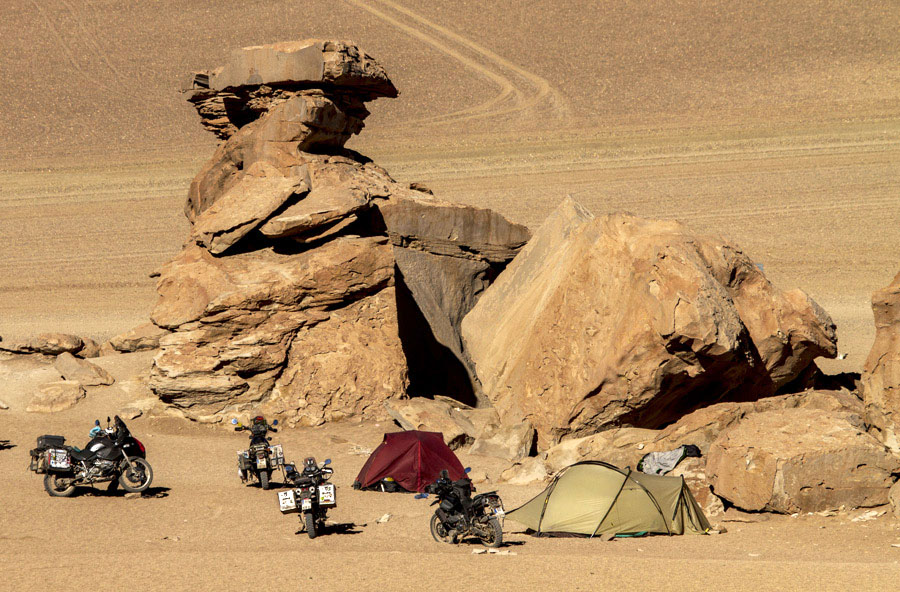Did this on my KTM LC8 a few years ago.
Met a couple of internet acquaintances at the Mexican border, headed for a Baja adventure. Had just ridden the bike from San Diego, CA to the Tecate crossing through the hills, with no issues at all.
As soon as we crossed the border into MX, almost literally 1 mile later, my clutch master cylinder began to fail. There are no KTM dealers in Baja, and we were in the first mile of a ~2400 mile trip to Cabo San Lucas and back.
Seeing the mineral oil leaking from the master, I deduced that the issue was likely a seal of some sort. One of the guys with me suggested that he saw a transmission shop at the bottom of the hill we had just come up, and figured that would be a place with a likely plethora of different seals on hand..
Fortunately I had a pair of circlip pliers in my kit, and was able to dismantle the master cylinder. While 2 of us were working on that, one of the guys went see if he could find mineral oil anywhere. He managed to find some lavender scented baby oil (3 dudes, and a bunch of small bottles of lavender scented baby oil, jokes ensued

). Fortunately he knew that baby oil is in fact mineral oil (I would not have known that personally).
-It is important to note that every time I disassembled the master cylinder, I did it while connected to the hose line, with the MC as high as possible to avoid air infiltration, then covered with a plastic bag to avoid contamination. When reassembling, I poured mineral oil into the cylinder, over filling a bit, before reinserting the piston, again in an effort to avoid air in the line. It seemed to work pretty well..
-Be careful, there is a large spring in there, and if you don't have pressure on the piston while releasing the circlip, parts will go flying!
The Transmission shop did not have any seals similar to the one on the piston for the master cylinder. They directed me to a local auto parts store, nothing useful, but met a guy on line that referred me to a local with an extensive old motorcycle/ dirt bike collection. No dice there, he referred me to a small cycle shop (mostly Chinese scooters), no luck there.. I probably spent a couple of hours chasing leads around town on one of the other guys bikes (while they waited). ...Mind you, I planned this trip, and these guys showed interest, then agreed to go along with me. Not the best impression, I'm sure.
Finally after following one last lead with no luck, then being referred by that individual back to the gentleman with the collection, I gave up.
After riding all over town, and pulling this part out of my pocket to show everyone, every time the part coming out of my pocket with less and less oil on it so that I could actually see the condition of the rubber better; It occurred to me that the seal was not actually torn or destroyed, it was just outdated, and a bit dried out...
There is a thread on the ADVrider website call "The Pine Sol Degreaser Thread" (good info there). Basically it outlines a process for cleaning carburetors using a solution of original pine sol and water.
-I have now used this process many times, and at that time a few times, to great success. However the first time I did it, I soaked the carbs with the rubber boots still on, and after a week or so, the rubber had swollen up so much beyond original dimensions, that I had to let them sit for a few weeks before they went back a usable dimension.
So with that thought, I headed to the nearest grocery store, bought the smallest bottle of pine sol (Pin Oil as it was called in this market) I could find, headed back to where the guys were waiting, and felt like I had a plan of action.
While putting the Master cylinder back together, I told them my plan was to shift without the clutch as much as possible (I've practiced this quite a bit on bikes and in cars, and am more comfortable/ confident than most with the technique), push on to Ojos Negros, soak the piston and seal overnight, and see how it was the next day. If it did not work, I had enough "mineral" oil to make it back to San Diego, and they could continue on without me. I capped off reservoir a couple of other times on the way, hoping to avoid getting any air in the line, and we made it to Ojos a bit later than we had originally intended, but in tact.
I soaked the part overnight in a styrofoam cup with a 50/50 mix of pine sol and warm water.
-Side note, this is a very pungent process, I retained the plastic cover on the cup to cap it as best as possible. It still smelt strong throughout the room, but it was tolerable.
In the morning, I lathered up some soap in my hands, drained the cup, and immediately rubbed the soap all over the part and the seal to avoid more than a quick "flash rust" oxidation on the surface, and to neutralize the pine oil's action. Rinsed and dried the part thoroughly, poured a little mineral oil over the surfaces for smoother installation, and reassembled.
I checked the reservoir level a few times per day over the next day or two, and it was always at the same level. Finally I resolved to just keep an eye on the now dry end of the master cylinder to check for leakage, and only check the reservoir if there was a hint of a problem.
We made it another 2000+ miles to Cabo and back to San Diego without having to add any more Mineral oil. I removed the master cylinder, put the bike in storage, and sent the MC out to be re-sleaved. I rebuilt the internals with new parts when it came back, and the bike is still going strong.
On this trip I also had to "bush fix" 2 broken upper tank bolts on a loaded down Husky 701, break the bead on a K60 to change a tube in the middle of nowhere (if you know, you know), and secure a right front brake caliper on an F800 that had come off, caught a few spokes, and gotten thrown into the upper fork tube/ seal area and started leaking..
Baja does present her challenges, but she also rewards those who persevere!!




















 1Likes
1Likes

 ). Fortunately he knew that baby oil is in fact mineral oil (I would not have known that personally).
). Fortunately he knew that baby oil is in fact mineral oil (I would not have known that personally). 






 Linear Mode
Linear Mode










